Search intent (also known as audience, keyword or user intent) is the term used to describe the reason behind an online search and what a user is hoping to find. It’s one thing to rank high on the SERPS, but you want to rank for the right words and optimise your content for search intent if you’re going to successfully convert users.
In this article, I’ll be highlighting the key types of search intent, how you can pinpoint the reason behind a search and why optimising your content for search intent is instrumental in a successful digital marketing strategy.
With Google processing an average of over 40,000 searches each second (over 3.5 billion searches a day), it’s more important than ever to get your brand in front of users making a search that’s relevant to your products and services. You want to improve your online visibility, but you also want to ensure that users stay on your site. A reason for a high bounce rate is when your content isn’t relevant to the user or has a misleading title tag so you should avoid optimising content just for search engines and think of the person behind the search.
Types of search intent and how to identify them
There are four main types of search intent that you should be aware of and consider when creating or optimising your content. They are as follows:
Informational
Informational intent is where a user wants to learn something about a person, topic, product, location…anything that they desire! A user may enter a question directly into a search engine if they’re looking for a particular answer, or, their search may be a little more vague. Google’s understanding of intent is very complex, and so, it knows that if a user searches for 'spaghetti bolognese', it’s likely that the user is searching for a recipe rather than looking for the history of a humble spag bol.
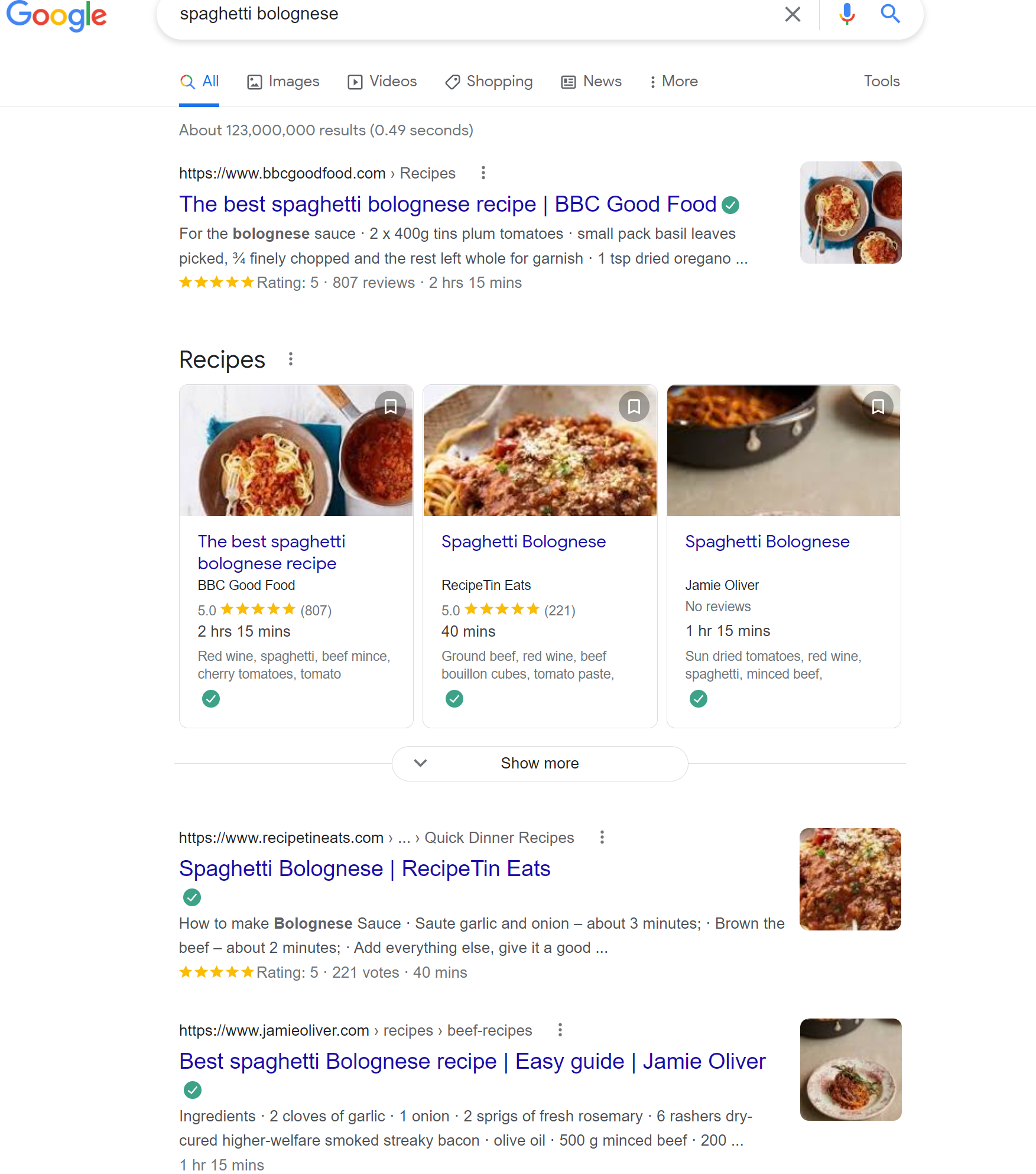
How to identify informational intent and how the results may appear in the SERP
As mentioned above, some searches can be ambiguous, but Google understands what the majority of users are likely to want. There are, however, certain keywords which indicate informational intent and common features on the SERP that correlate to the intent.
Words typically included in the search include:
- Who
- What
- Where
- When
- Why
- Guide
Common SERP features include:
- Recipes
- Knowledge panel
- Featured snippets
- News articles
- Video results (often ‘how-to’ videos)
- ‘People also ask’
Just from performing a search on Freddie Mercury, Google knows that I’m looking for information about the iconic singer and I see the following SERP features:
Featured snippet

Knowledge panel
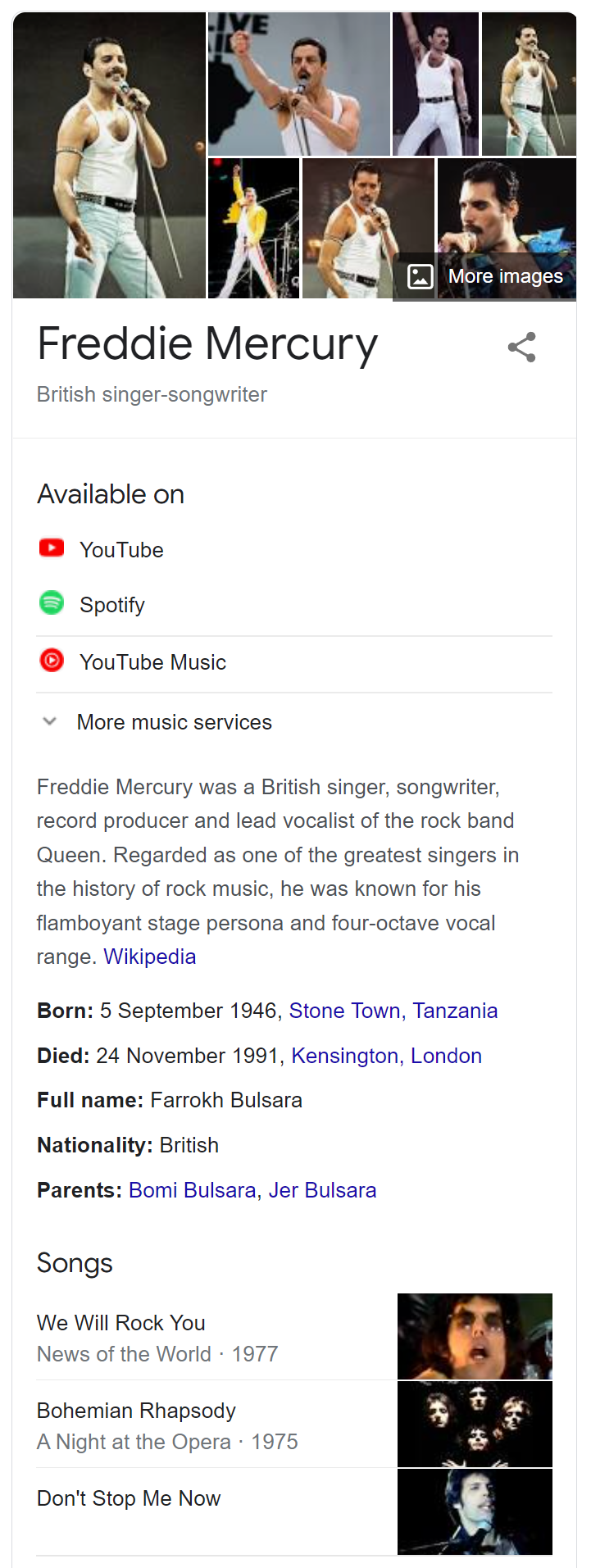
News stories
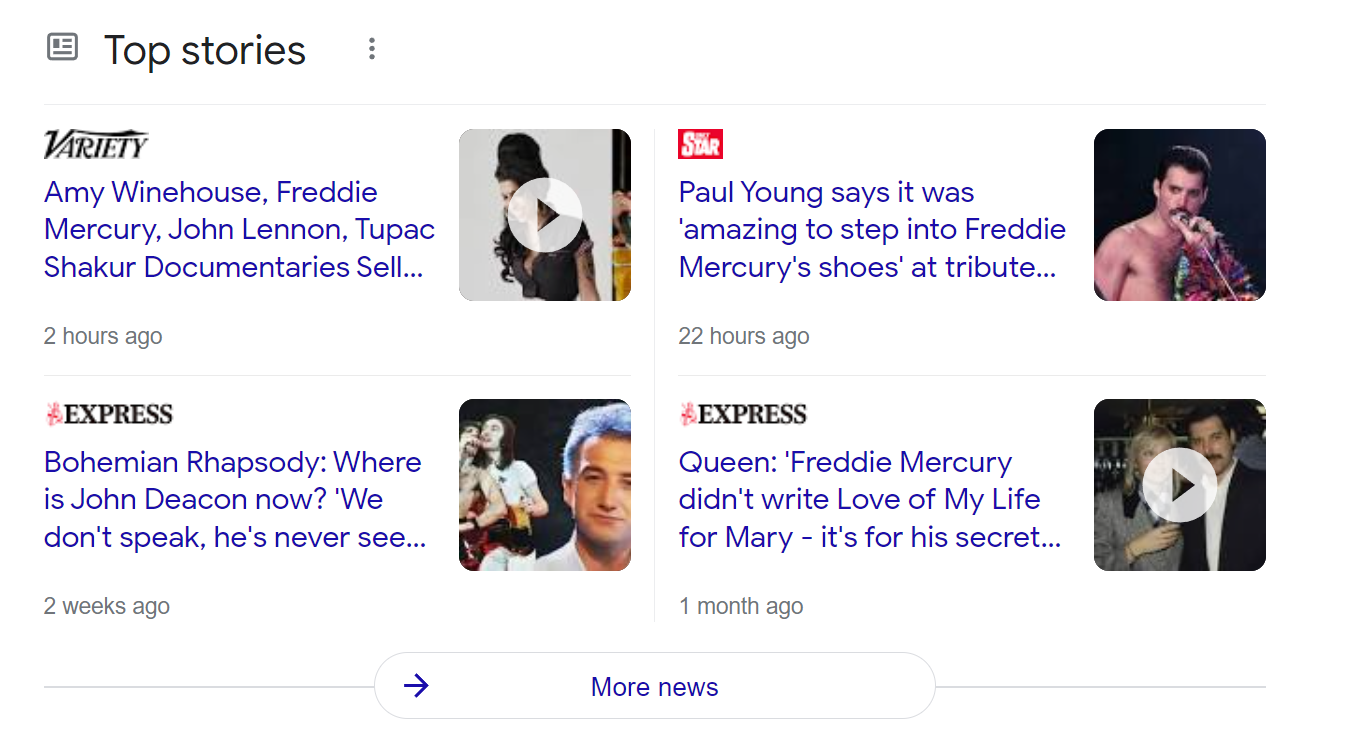
All of the above are designed to offer users more information (such as Mercury’s biography, answers to common questions about the singer and related articles). Before you look to optimise your content for search intent, you can have a look at what Google currently ranks as relevant to a search query.
Adding structured data to your site can help search engines to understand the content of your webpages and enable you to have rich results on the SERP. There are different types of structured data which suit different search intent purposes (including data for reviews, products, videos, FAQs and more). When it comes to adding structured data for informational intent, you could consider adding FAQ schema for the FAQs included on a page (your answers can then appear under ‘People also search’) or recipe schema (if relevant) which will enable Google Assistant to guide users through your recipe on smart displays and Google Home.
As a business, you need to be creating informational content to create brand authority, build trust with your customers and increase brand awareness. With the majority of online searches having informational intent, you have an opportunity to answer users’ questions whilst demonstrating your expertise to the right audience.
Commercial
Commercial intent is where the user is searching for a particular product or service but still needs to make a final decision on the best solution for their needs. Typically, they’ll be looking for reviews and comparison sites.
How to identify commercial intent and how the results may appear in the SERP
Commercial keywords will involve users searching for brands, products or services. Below are some of the common words in a commercial search and the features on the SERP that correlate to the intent.
Words typically included in the search include:
- Reviews
- Best
- Top
- Vs
- Compare/comparison
- Brand name
- Product attributes
Common SERP features include:
- Reviews
- Shopping ads
- ‘People also ask’
- Video results (review/comparison based)
You can see these SERP features by searching ‘best gymshark leggings’. Google understands that the user is yet to make a purchase decision so it is displaying shopping ads (with reviews), review blogs, common questions about finding the right product and videos of people comparing Gymshark leggings. All of these results are designed to give the user the information they need to make a decision.

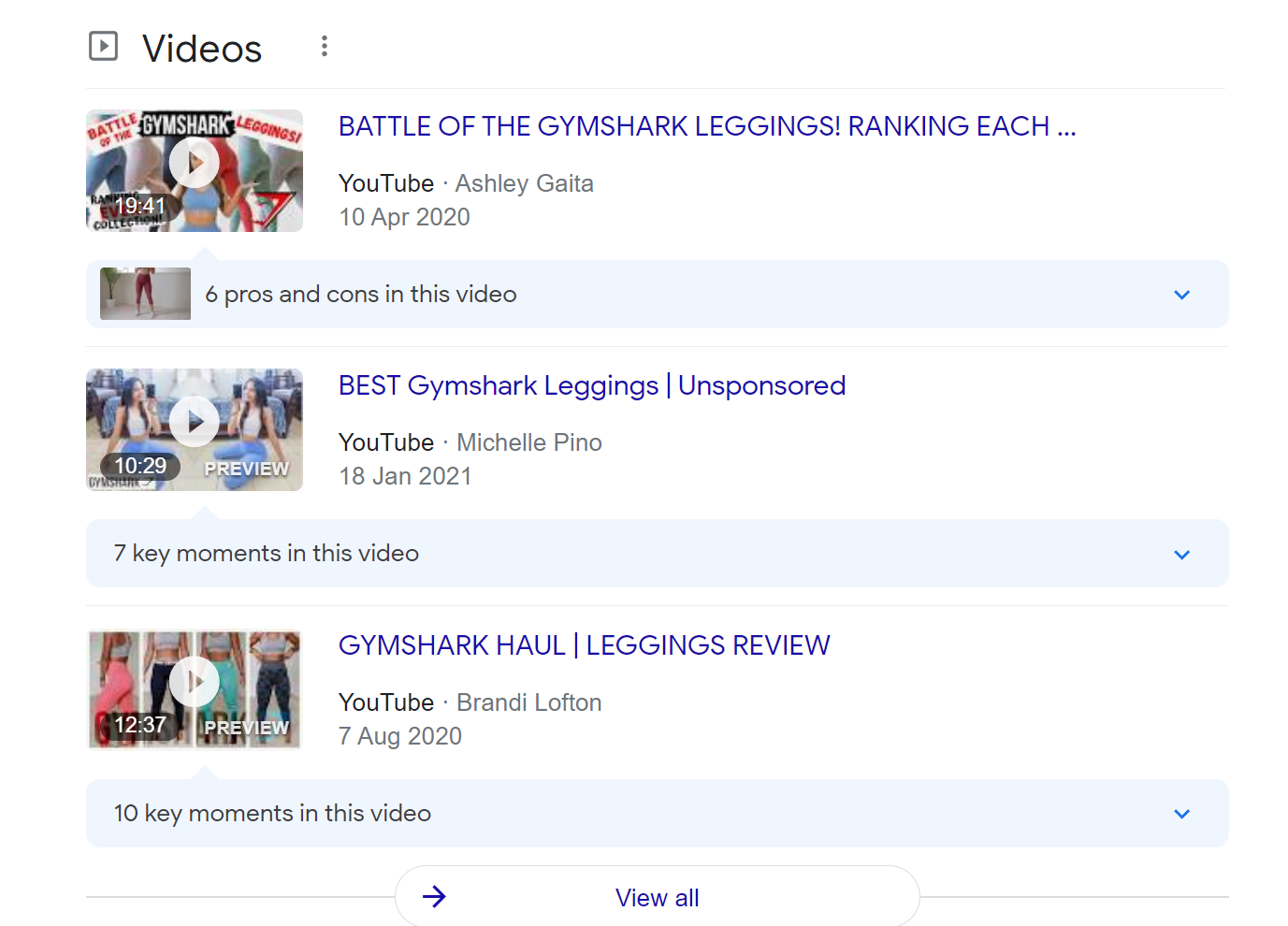
There’s even a review feature on the SERP that highlights review-based articles, making it easy for users to get the information they need to make a purchase decision.
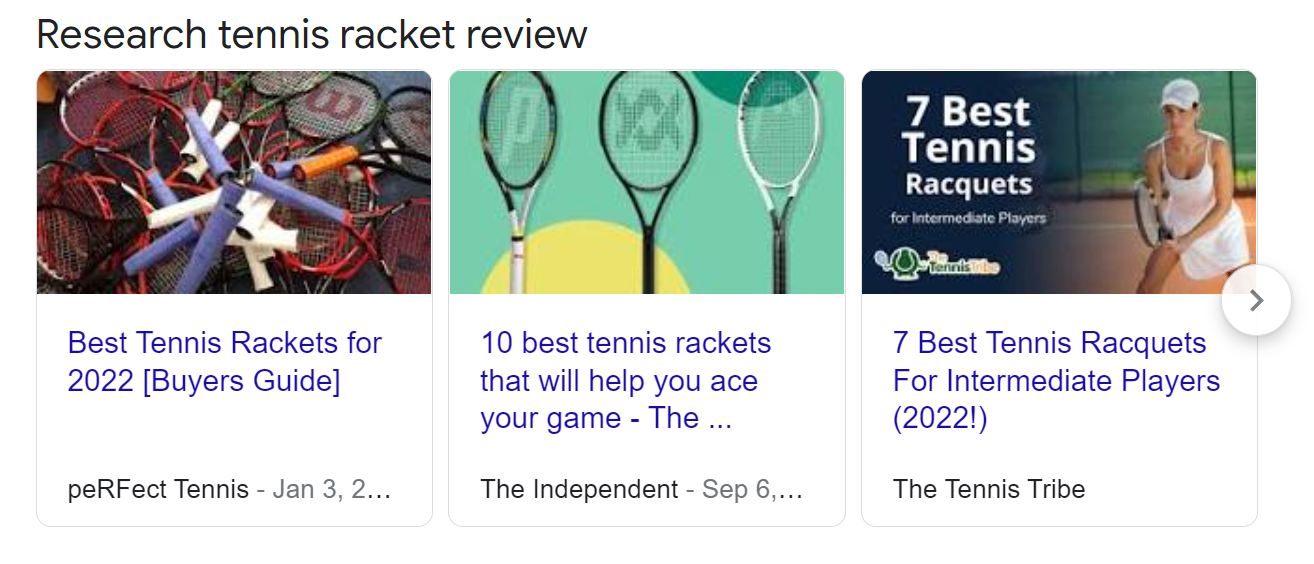
When optimising your content for commercial intent, you need to show your target audience what you have to offer and provide them with the information they need to encourage them to convert. Once you understand what it is users are looking for, you should target commercial keywords and structure your content in a way that presents the answer users want easily.
In terms of structured data, you could consider adding FAQ, product and review schema markup. Product schema will indicate what you’re selling to search engines and review schema will highlight its quality. Positive reviews show that your site is trustworthy and your products or services are recommended which improve your Expertise, Authority and Trustworthiness (E-A-T) score can inspire a conversion.
Commercial intent can often get confused with transactional intent. We’ll discuss the latter next but all you need to remember is that commercial keywords are for users who are still investigating a brand, product or service and aren’t yet ready to complete an action.
Transactional
Transactional intent is where the user is ready to make a purchase or do something specific (such as register for a service). The user is likely to know what it is they wish to buy and they’re looking for somewhere to buy it from.
How to identify transactional intent and how the results may appear in the SERP
Below are some of the common words used in a transactional search and the features on the SERP that may appear.
Words typically included in the search include:
- Buy
- Order
- Offer
- Discount
- Price
- Product names
- Quotes
- Near me
Common SERP features include:
- Shopping results
- Local pack
- Popular products
Shopping results are a common SERP feature for transactional searches. In the below screenshot, you can see that by searching for a protein bar subscription, shopping ads appear alongside results for subscription services.
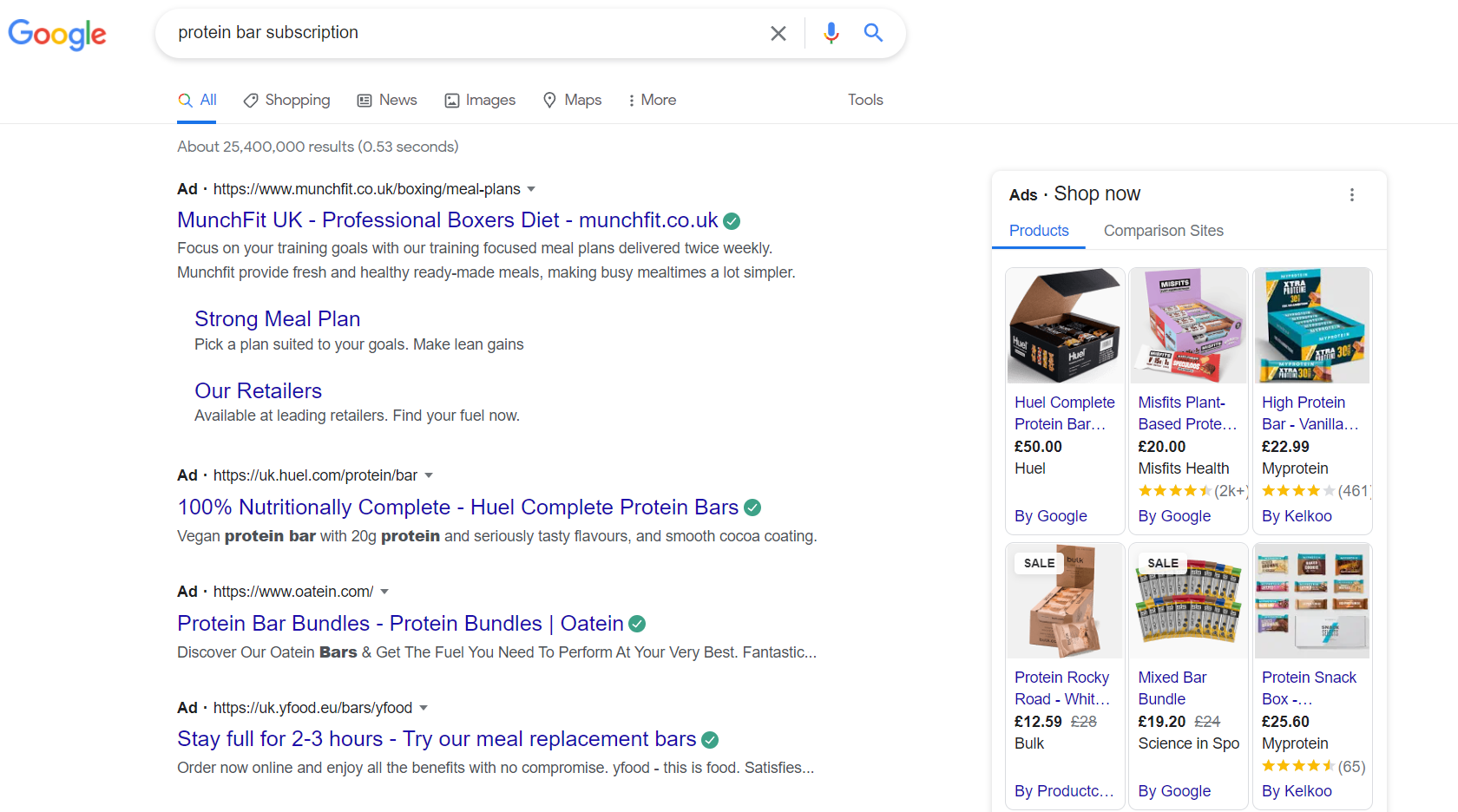
When performing a ‘near me’ search, users will typically be presented with a local pack SERP feature which lists nearby locations where they could purchase a product or service and the contact details of these businesses.
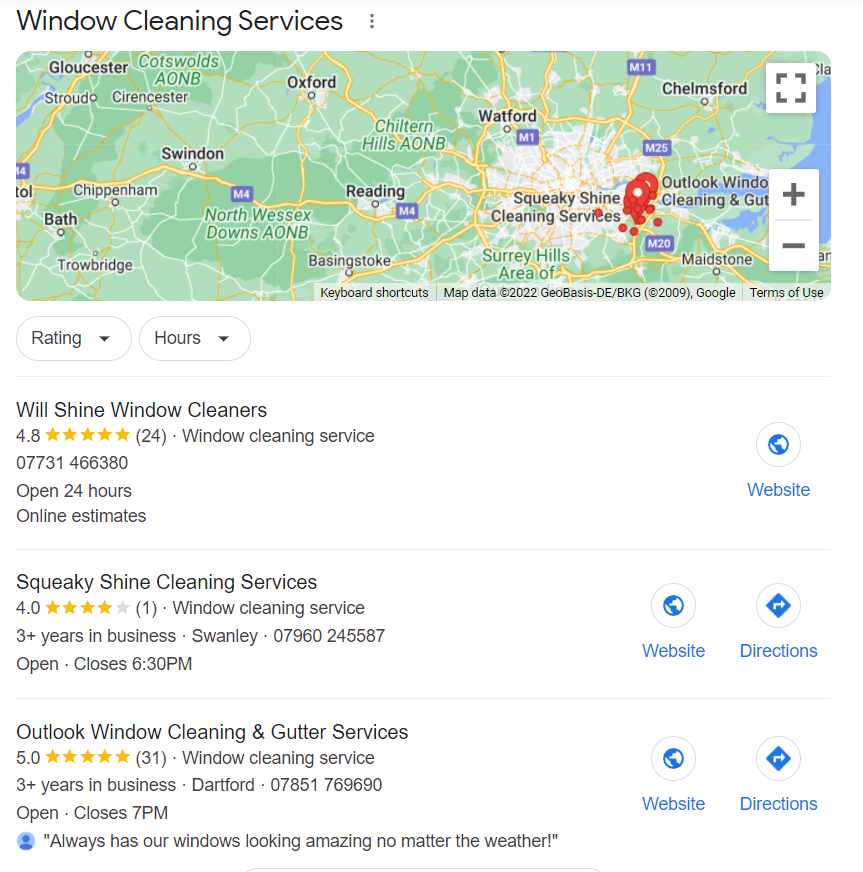
If you’re optimising your content for transactional intent, you need to understand your goals and what a successful conversion is for you (i.e. is it users signing up to emails? Purchasing a product? Or something else?). You also need to provide relevant information about the product or service you’re offering and make the conversion process as simple as possible (for example, you should have a clear CTA and user-friendly web design).
You can also look to add structured data such as local business schema (which highlights your business offerings and location), product schema (to highlight what you’re selling) and review schema to show what other customers are saying about their purchase. As mentioned earlier, positive reviews can inspire conversions.
Navigational
Navigational intent involves a user searching for a specific site, page or location. They already know where they want to go, so your job is to take them there.
How to identify navigational intent and how the results may appear in the SERP
Below are some common words used in a navigational search and the SERP features you can expect to see.
Words typically included in the search include:
- Brand names
- Contact
- Blog
- Log in
Common SERP features include:
- Site links
- Knowledge panel
When a user searches for your brand name, search engines should give authority to your site. You can optimise your site for navigational intent by including branded keywords and search queries. In terms of structured data, you can add breadcrumb schema markup which highlights the page’s position on the site hierarchy and allows for site links to be displayed on the SERP - making it easy as pie for users to navigate to the page they’re after. I’ve highlighted the breadcrumbs and site links that appear on a result for ‘pretty little thing skirts’ below.

Knowledge panels are also a common SERP feature for navigational intent. They provide information about the brand, link to social media platforms, list competitors and more.
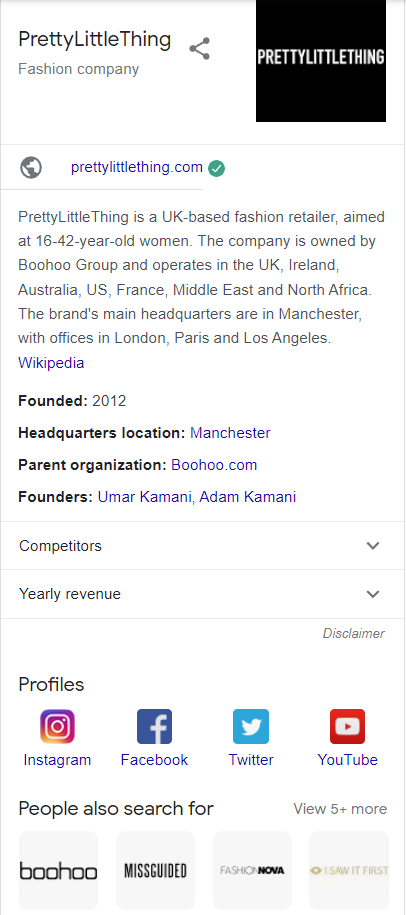
When looking to optimise your webpages for navigational intent, consider branded search and making your site simple to navigate for a positive user experience. You can add breadcrumb schema (as highlighted above) and organisational schema (which describes your organisation and enhances your knowledge panel as it allows you to input information such as your brand logo, address and links to your social media profiles).
So, those are the key types of search intent. Below is a table summarising them so you can easily compare their differences.

Identifying search intent isn’t always easy
Google continues to become increasingly sophisticated and capable of understanding user intent. That said, sometimes a search is a little ambiguous and the intent may be unclear. For example, if a user searches for the name of a product, they could be looking for more information about it, looking for a review or looking to purchase it. In cases such as this, Google will present a variety of SERP features so that the user can find the result that best matches their intent.
It’s worth bearing in mind that even when search intent is clear, you should check out the competition. Pay attention to what’s currently ranking on page one of the SERPs as they’ve passed Google’s search intent test and your content should match these types of results.
Why optimising your content for search intent is important
On a final note, let’s reflect on why optimising your content for search intent is absolutely essential:
1. You can create meaningful content
By taking the time to consider the reason behind a search, you can better tailor your content to give the user what it is they’re looking for. If your page doesn’t give them what they want, you’ll likely see a high bounce rate as they’ll leave your site in search of someone who will. If your content is designed for the user (and not just search engines), there’s a high chance they’ll be motivated to explore your site further.
2. You can help search engines understand your content
Keywords aren’t really enough on their own these days. By optimising your webpages for search intent (such as adding relevant schema and ensuring the information included is relevant), you can make it clear to search engines what your offerings are and demonstrate why you should be ranking high for certain keywords.
3. You can increase conversions
If your content matches user intent, a user will be more likely to convert as you’re giving them exactly what they need. Whether that’s useful information about a product in an FAQ section or you have sitelinks in the SERP which makes it easy for users to find the right page, positive user experience will show in your conversion rate.
4. You can improve your local business traffic
Don’t lose out on business by forgetting to optimise your content for local traffic. With approximately 72% of online shoppers performing a local search visiting a store that’s appeared in the results if it’s within five miles, you need to make your location known. As mentioned earlier, you can add local SEO schema markup to your website so that when a user searches for a service ‘near me’ or types in a location, you’ll be right in front of them.
5. It’s more cost-effective
By ensuring that your content is fit-for-purpose and tailored to user intent, you can increase your return-on-investment for your PPC and SEO campaigns as more users are likely to convert.
Looking to optimise your content for search intent? We are Adido, a commercially-focused digital marketing agency with over 19 years of experience under our belt in helping clients drive their business forward. Whether you’re looking to improve your SEO or PPC campaigns for search intent, we can help your business to evolve and see better results. Get in touch with us today for more information.




